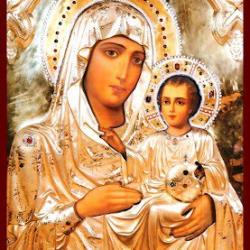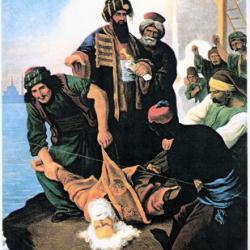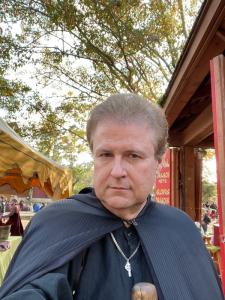![]() Any story about Jesus takes place in two times: God’s time and human history. I am not saying this philosophical idea was fully worked out in the mind of Saint John, but is suggested to readers by the details of the Gospel and the teachings of the Old Testament. The events of the Incarnation are the intersection of time and eternity.
Any story about Jesus takes place in two times: God’s time and human history. I am not saying this philosophical idea was fully worked out in the mind of Saint John, but is suggested to readers by the details of the Gospel and the teachings of the Old Testament. The events of the Incarnation are the intersection of time and eternity.
The liturgical understanding of John 11 suggests the view of Divine timelessness like that found in Boethius’ Consolation of Philosophy: “God is eternal; in this judgment all rational beings agree. Let us, then, consider what eternity is. For this word carries with it a revelation alike of the Divine nature and of the Divine knowledge. Now, eternity is the possession of endless life whole and perfect at a single moment.”* While some philosophers have attacked the coherence of Boethius idea, philosophers such as Norman Kretzmann and Eleonore Stump have ably defended it.**
The traditional Christian view that God exists in an eternity (“timelessly”), possessing life in a single moment, makes sense of the raising of Lazarus and theological meaning. From the perspective of God: Christ is coming, Christ is come, Christ will come again is how God experiences. God never waits, never grows impatient. There is only one day for God: the Day of the Lord and it is now.
What is the relationship of God’s eternal present to human time? We must unpack the ways “in time” is used, because with one way of using the phrase God “is in time” and in other usages He is not!
First, God is “in time” using one common use of the phrase “in time.” Second, the story of Lazarus sometimes speaks of time differently and in this sense God is not in time.
I believe Biblical writers usually view time as “the moment of action.” Time is the medium in which events can take place. When does Isaiah see the Lord? Isaiah sees the Lord in the year that King Uzziah dies. Time is important as the “location” of an event. Something exists or a state of affairs is actualized in time. This is a commonsense way of thinking about time and since God exists He is in time (in this sense of time.)
Many later Christian philosophers had a different use of the term “time” and what it means to be “in time.” These philosophers were influenced by Platonism and Neo-Platonism, but also by hints in Scripture such as those in the story of the raising of Lazarus or phrases like the “day of the Lord.” For these thinkers “time” is a term for the “medium of change” and so God must be timeless. Augustine in the City of God XI and Chapter 6 sums up the case for divine timelessness when he states that there is no time in eternity, because eternity admits no change. God admits no change; therefore, He cannot be “in time” in this sense. He is in “eternity.”
God’s time (GT) is when God has His full existence if we use the commonsense usage of time. According to the Augustinian view; however, GT is not time at all, because there is only one instant of GT. GT admits no change: it is “eternity.”
GT is the “moment” or single time in which the state of affairs capturing God’s existence is actualized. It is the moment of I AM. It is not like our own “time” in which our changing state of affairs is actualized.
GT is “time-like” in that an action takes place there: God has His eternal will in GT. It thus meets the common or early notion of what time is: the “place” where one thinks and wills. GT is “timeless” in that the state of affairs actualized at GT never changes. All of God’s willing and thinking occur simultaneously: they are one.
Our time, containing past, present and presumably future states of affairs (change) is best pictured as a line. There is one instant, and only one instant, of GT because GT admits no change. This moment of GT is not a set of identical moments occurring in parallel to each individual moment of T. GT is distinct from T. This combines the Boethius’ insight with more usual understanding of what it means to be “in time.”
When a state of affairs comes to pass in T, a man can ask the concurrent state of affairs in eternity. The answer is always the same, since eternity never changes. The “time” in eternity (in the Biblical sense of when a state of affairs occurs) is always the same. We might call that GT moment “X.” From our vantage point it is always X in GT. Since God created T with the cosmos, on the view of Boethius, the starting point of T, before the first change had occurred that brought forth the creation was also X.
T is a “ray” running from GT at a point X. It is not a time segment, because humankind and our cosmos are recreated and not destroyed in the Christian apocalypse, but we are never “god.” To admit us to eternity (GT) would be to admit change to GT. We have never lived in eternity and never shall: mere eternal duration is not GT.
GT’s X is the starting point for T. (This picture captures the Augustinian notion that time begins “out of” eternity.) T, a “ray” is distinct from GT, “a point”, though it interacts with GT. This separates my picture from that of C.S. Lewis.
It is possible that there are other time “rays” and creations that would begin out of GT. The whole picture is like a great wheel with GT forming the hub
of the wheel and various possible time “spokes” or states of affairs extending from that one hub.
There is at least one such actual “time” ray, namely the time “ray” we live in at present: T. At any point along the “ray” if one asked what the time was in GT, the answer would always be X. Events can occur in either “spokes” or at the “hub.” Simple use of language, like that found in the Bible, might refer to both as “time.” Later Christian philosophers would only call the ray “time” and would refer to the hub (GT) as “eternity.”
GT is also unique from T in that God only exists in His fullness in GT. God exists only at X (as a subset of GT). The cosmos exists from (or through) X during T and contains everything in our cosmos except for God (strictly speaking). God interacts with T, but does not exist in T.
GT is not merely part of “ray” T (unlike other unique moments of time in “ray” T), because other potential time lines stretch from GT. God as creator has (or had) the ability to create other possible time “rays” from the moment X (even if He has not or does not in fact do so). Since God exists eternally at X and not (strictly speaking) at any moment of T, there are no possible “rays” of time stretching from any moment of T. GT’s point X (its only point) is potentially the starting point for an infinite number of created times.
GT, the eternity of Boethius, becomes a subset of a broader term called “time” by Biblical writers. T, (the sequential moments of our cosmos: past, present, and future) is a second subset of this broad notion of time: the medium of change in some sequence.
Applied to the raising of Lazarus, we can see the different uses of time. Jesus “waits” during some duration of T, but in eternity (GT) Lazarus is raised already. In T sin and death exist, but in GT the Lamb slain from the foundation of the world has defeated sin and death. Jesus weeps from the perspective of T and has faith based on his knowledge of GT.
The “sickness is not unto death” from the eternal perspective: Lazarus is alive, because there is no death at GT. Lazarus dies in T and remains dead for some duration of T. There is no contradiction.
How can Jesus say we shall “never die” if we believe in Him? If our life is hidden in God, then it is in a place where no change can take place. We might experience death in this life (some moment of T), but where God is we are alive. A man cannot be alive and dead at the same time, but he can be alive and dead at two different times.
To endure change and pass through to the victory that already is in Heaven (GT) must have been almost unendurable for Jesus. Lazarus is alive (GT), but Lazarus is dead (in T) and Jesus must endure T. We ask that God’s will be done in this age (T) as it is already is in Heaven (GT). Our own time, human history, is transformed whenever any man or woman allows his or her vision to clear and see God in His time.
Looking at an icon on my wall of my house, I see two reactions to the great miracle picture on it. Some followers worship the Lord of Life, but others turn to plot His death. The God revealed in Jesus is the Jewish Messiah and in the raising of Lazarus is shown to be the very Son of God: equal to God. Surprisingly to moderns, not all embrace life when they see it.
The story of Lazarus ends with the opponents of Jesus expanding their hit list from Jesus to Lazarus. They saw life and embraced death. As Christians we too have two natures: the inheritance of Adam and the inheritance of Jesus Christ.
Much evil that exists is best explained by our perverse desire to embrace death and turn away from Life. It is also foolish, because Life exists in a time where no human can ever touch it: GT (eternity).
.Jesus is in history, but (except perhaps when forsaken on the Cross) also alive in GT. The Word became flesh and dwelt among us. We could see Him, but He also could see the Father and do what He was (eternally) doing.
We will die in this time, but if we believe in Him then our true life will be hidden in a place where death and change are impossible. Christians never die: it is always Easter Sunday.
———————
*Boethius, Consolation of Philosophy, Book V.VI.
**Stump, Eleonore and Kretzmann, Norman, 1981, ‘Eternity’, Journal of Philosophy 78(8): 429–458.
















